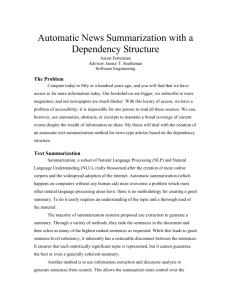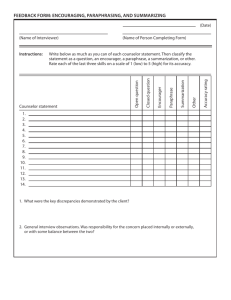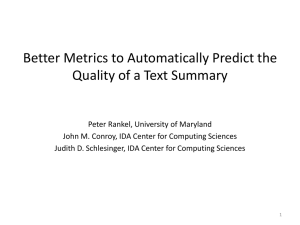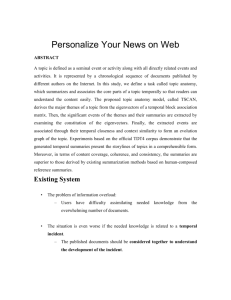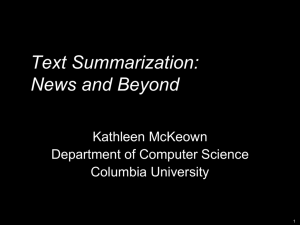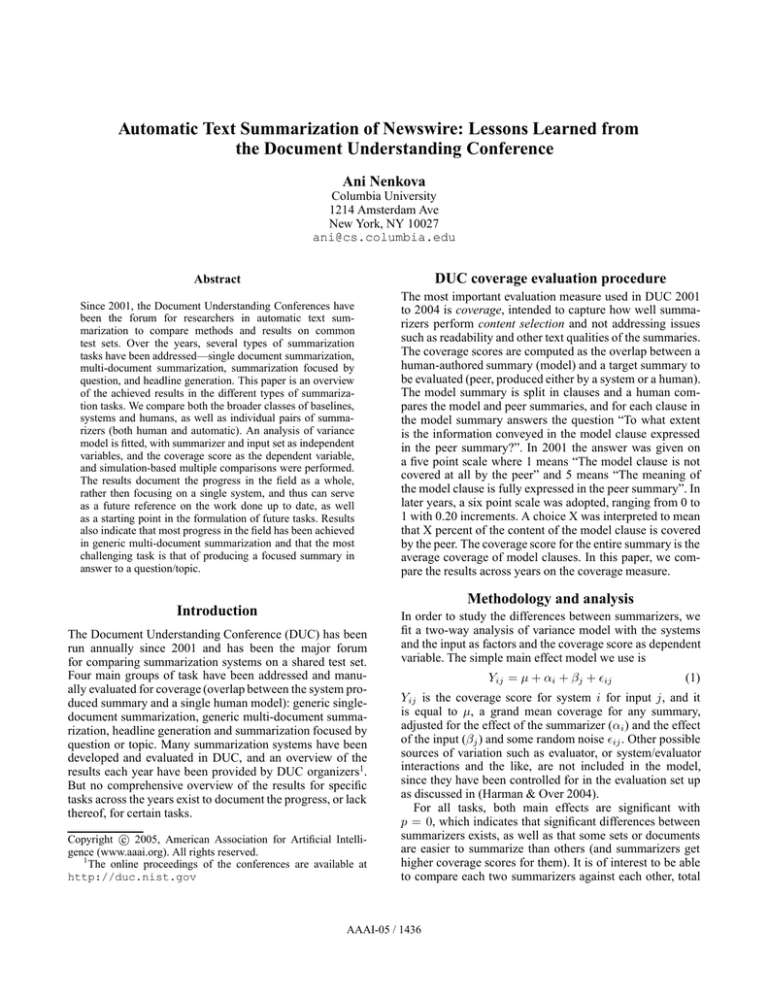
Automatic Text Summarization of Newswire: Lessons Learned from
the Document Understanding Conference
Ani Nenkova
Columbia University
1214 Amsterdam Ave
New York, NY 10027
ani@cs.columbia.edu
Abstract
DUC coverage evaluation procedure
Since 2001, the Document Understanding Conferences have
been the forum for researchers in automatic text summarization to compare methods and results on common
test sets. Over the years, several types of summarization
tasks have been addressed—single document summarization,
multi-document summarization, summarization focused by
question, and headline generation. This paper is an overview
of the achieved results in the different types of summarization tasks. We compare both the broader classes of baselines,
systems and humans, as well as individual pairs of summarizers (both human and automatic). An analysis of variance
model is fitted, with summarizer and input set as independent
variables, and the coverage score as the dependent variable,
and simulation-based multiple comparisons were performed.
The results document the progress in the field as a whole,
rather then focusing on a single system, and thus can serve
as a future reference on the work done up to date, as well
as a starting point in the formulation of future tasks. Results
also indicate that most progress in the field has been achieved
in generic multi-document summarization and that the most
challenging task is that of producing a focused summary in
answer to a question/topic.
The most important evaluation measure used in DUC 2001
to 2004 is coverage, intended to capture how well summarizers perform content selection and not addressing issues
such as readability and other text qualities of the summaries.
The coverage scores are computed as the overlap between a
human-authored summary (model) and a target summary to
be evaluated (peer, produced either by a system or a human).
The model summary is split in clauses and a human compares the model and peer summaries, and for each clause in
the model summary answers the question “To what extent
is the information conveyed in the model clause expressed
in the peer summary?”. In 2001 the answer was given on
a five point scale where 1 means “The model clause is not
covered at all by the peer” and 5 means “The meaning of
the model clause is fully expressed in the peer summary”. In
later years, a six point scale was adopted, ranging from 0 to
1 with 0.20 increments. A choice X was interpreted to mean
that X percent of the content of the model clause is covered
by the peer. The coverage score for the entire summary is the
average coverage of model clauses. In this paper, we compare the results across years on the coverage measure.
Methodology and analysis
Introduction
The Document Understanding Conference (DUC) has been
run annually since 2001 and has been the major forum
for comparing summarization systems on a shared test set.
Four main groups of task have been addressed and manually evaluated for coverage (overlap between the system produced summary and a single human model): generic singledocument summarization, generic multi-document summarization, headline generation and summarization focused by
question or topic. Many summarization systems have been
developed and evaluated in DUC, and an overview of the
results each year have been provided by DUC organizers1.
But no comprehensive overview of the results for specific
tasks across the years exist to document the progress, or lack
thereof, for certain tasks.
c 2005, American Association for Artificial IntelliCopyright gence (www.aaai.org). All rights reserved.
1
The online proceedings of the conferences are available at
http://duc.nist.gov
In order to study the differences between summarizers, we
fit a two-way analysis of variance model with the systems
and the input as factors and the coverage score as dependent
variable. The simple main effect model we use is
Yij = µ + αi + βj + ij
(1)
Yij is the coverage score for system i for input j, and it
is equal to µ, a grand mean coverage for any summary,
adjusted for the effect of the summarizer (αi ) and the effect
of the input (βj ) and some random noise ij . Other possible
sources of variation such as evaluator, or system/evaluator
interactions and the like, are not included in the model,
since they have been controlled for in the evaluation set up
as discussed in (Harman & Over 2004).
For all tasks, both main effects are significant with
p = 0, which indicates that significant differences between
summarizers exists, as well as that some sets or documents
are easier to summarize than others (and summarizers get
higher coverage scores for them). It is of interest to be able
to compare each two summarizers against each other, total
AAAI-05 / 1436
sys
1
A
B
C
D
E
F
G
H
I
J
15
16
18
19
21
23
25
27
28
29
31
better than systems
15 16 17 18 23 25 30
1 15 16 17 18 21 23 25 31
1 15 16 17 18 19 21 23 25 27 28 29 31
1 15 16 17 18 19 21 23 25 27 28 29 31
1 15 16 17 18 19 21 23 25 27 28 29 31
1 15 16 17 18 19 21 23 25 27 28 29 31
15 16 17 18 23 25 29 31
1 15 16 17 18 19 21 23 25 27 28 29 31
1 15 16 17 18 19 21 23 25 27 28 29 31 A F J
1 15 16 17 18 19 21 23 25 27 28 29 31
15 16 17 18 23 25 29 31
17 25 30
17 30
17 30
15 16 17 18 23 25 30
15 16 17 18 25 30
17 25 30
17 30
15 16 17 18 23 25 30
15 16 17 18 23 25 30
16 17 18 25 30
16 17 18 25 30
Table 1: Significant differences based on 95% confidence intervals for single document summarizers in 2002. The second column lists the summarizers that the summarizer in the
first column is significantly better than.
of N2 comparisons when N is the number of summarizers.
Thus, the number of pairwise comparisons to be made is
quite large, since each year more than 10 automatic summarizers were tested and several human summarizers wrote
summaries for comparison purposes. In order to control the
probability of declaring a difference between two systems
to be significant when it is actually not (Type I error), we
use a simulation based multiple comparisons procedure
that controls for the overall experiment-wise probability of
error. 95% confidence intervals for the differences between
system means are computed with simulation size = 12616.
Pairs of summarizers where the confidence interval for the
difference between the two means excludes zero can be
declared to be significantly different.
Summarizer codes conventions
In all years and tasks, human summarizers have letter codes
A to K. Baselines have codes 1 to 5. The remaining codes
are those for participating systems. Each year, non-model
human summaries were available for each set/document, but
no human wrote summaries for all the sets. This means that
the average scores for humans are estimated from a smaller
sample than those of system averages.
Generic single-document summarization
The generic single document summarization task was addressed in DUC 2001 and 2002, with target summary length
of 100 words. The baseline in both years, with summarizer
code 1, was the same: taking the first 100 words of the input
document. Space constraints would not permit to list all 507
pairwise comparisons and the respective 95% confidence interval, so table 1 lists only the pairs of summarizers where a
significant difference could be declared in 2002. The trends
are similar in 2001, with humans performing better than systems and the baselines, and systems not outperforming the
baseline. The peer averages for 2001 are not listed since the
coverage evaluation was done on a different scale from the
one used in following years and thus results across years
cannot be compared to track progress. The peer averages for
2002 are given in table 2.
Both years, none of the systems outperforms the baseline
(and the systems as a group do not outperform the baseline)
and in fact the baseline has better coverage than most of the
automatic systems (see the first row in table 1). It has often
been noted that this baseline is indeed quite strong, due to
journalistic convention for putting the most important part of
an article in the initial paragraphs. But the fact that human
summarizers (with the exception of F and J) significantly
outperform the baseline shows that the task is meaningful
and that better-than-baseline performance is possible. The
difference between the worst human and the baseline is 0.1
while the difference between the best system and the baseline is 0.01. Seven out of the nine human summarizers are
significantly better than all the systems, but humans F, J and
A are not significantly better than all systems. This suggests
that while humans as a group are much better than automatic
summarizers, specific human summarization strategies are
not so good and do not lead to significant advantage over
some automatic systems. These facts indicate that while the
single-document task has not been kept in later years, the
task remains an open problem.
Generic multi-document summarization
Generic multi-document summaries were produced in 2001,
2002 and 2004, with target lengths of 50, 100, 200 and 400
words in 2001 and 50, 100, and 200 words in 2002 and 100
words only in 2004. The two baselines used are 1) the first
n words of the most recent document (corresponding to system code 1 in 2001 and code 2 in 2002) and 2) the first sentence from each document in chronological order until the
length requirement is reached (codes 2 and 3 in 2001 and
2002 respectively). Note that the first baseline is equivalent
to what is currently used in news aggregation systems such
as Google News. Automatic summarizers in general perform
better than this baseline as can be seen in table 3 and table
4. The peer averages for 2002 and 2004 are given in tables 5
and 6 respectively.
When the target summary size is added as a factor in
the analysis of variance model, it is highly significant with
p < 0.0001 and multiple comparisons between the between
the four lengths in 2001 show that scores significantly increase as the summary size increases. This indicates that the
summary size impacts coverage scores and thus when performing evaluation one should control for the size of summaries that are being compared. If size is not controlled
for, it can confound the results in coverage scores comparisons. An interesting questions arises of what would happen
AAAI-05 / 1437
summarizer
coverage
sums
1
.37
291
15
.33
295
16
.30
295
17
.08
292
18
.32
294
19
.39
295
21
.37
295
23
.34
289
25
.29
294
27
.38
292
28
.38
295
29
.36
294
summarizer
coverage
sums
30
.06
294
31
.36
292
A
.47
30
B
.51
30
C
.46
24
D
.52
30
E
.49
30
F
.47
25
G
.54
25
H
.57
30
I
.53
29
J
.47
30
Table 2: Summarizer code, coverage and number of summaries for the single document summarization task at DUC 2002
2
A
B
C
D
E
F
G
H
I
K
L
M
N
P
R
S
T
Y
1UW
12LMOPRSUWYZ
12LMNOPRSUWYZ
12LMNOPRSUWYZ
12MORSUWZ
12HLMNOPRSTUWYZ
12HLMNOPRSTUWYZ
12LMNOPRSUWYZ
1UWZ
12LMNOPRSTUWYZ
12LMNOPRSTUWYZ
1UWZ
1U
1MORSUWZ
1UWZ
1UY
1UW
12MORSUWZ
1MOUWZ
tently. Several interesting observations can be made from the
data in table 3 (the results from 2001).
1. Only one system significantly outperforms the baseline of
selecting first sentences from the input articles (Id=2).
2. Not all humans significantly outperform all automatic
systems. This is very positive and indicates that on a set
of 30 input clusters, humans do not perform significantly
better2 .
3. Eight (out of 12) systems outperform baseline 1 (selecting the first N words of one of the articles in the cluster).
This approach is used by news aggregation sites, such as
Google news. The DUC results show that overall, specifically developed multi-document summarization systems
perform better than such a baseline.
Table 3: Significant differences for the 2001 multi-document
task. The summary length has been added as a factor in the
analysis of variance model.
if systems are compared separately at different target summary lengths—would the results differ. For the 2001 data,
we compared the groups of systems, humans, and baselines.
At all lengths the humans performed significantly better than
both the systems and the baselines. But the difference between the baselines and the automatic systems is significant
only for summary lengths of 200 and 400 words and is not
significant for target length 50 or 100 words. The same trend
can be seen in the 2002 data as well (table 4). The inability to show significance in the difference between systems
and baselines with shorter summary lengths might mean two
things. The evaluation method might be too restrictive, measuring the overlap with a single human model. The work of
(Nenkova & Passonneau 2004) discusses an alternative evaluation approach that looks for overlap between the summary
to be evaluated and multiple human models, which is less
restrictive and allows for the possibility that there might be
more than one, different, but equally acceptable, summaries
for the same input. It will be interesting to see if in upcoming
DUC competitions the new pyramid scoring procedure will
lead to greater ability to show significance. Another possible explanation is that as a shorter summary length is required, the task of choosing the most important information
becomes more difficult and no approach works well consis-
4. In the comparisons between different humans, only two
are significant (E and F are both significantly better than
H). The fact that there are significant differences between
human summarizers suggests that a cognitive study of the
human summarization techniques can be useful in shedding light for the development of automatic summarizers.
Figure 1 shows a pair of summaries written on for the
same input by humans F and H. The examples give an idea
why the unusual summarization strategy of H can lead to
worse summaries. Summarizer H also happens to be the human that does not outperform significantly most of the automatic systems.
Table 4 shows the significant pairwise comparisons between multi-document summarizers for 2002. These data
also indicate that more pairs are significant when longer
summaries are compared. It is again encouraging that several automatic systems are not significantly worse than humans. Table 7 gives the pairs of significantly different summarizers from DUC 2004.
The generic multi-document summarization task is the
only one evaluated in the same way across several years.
For the 100 word summary in 2002, the best system result
is 0.24, while in 2004 it is 0.30, and the average of system
coverage was 0.17 and 0.21 respectively. The difference is
significant according to a Wilcoxon rank-sum test (p-value
= 0.02). This could be an indication that there is an improvement of systems across the years. Unfortunately, such
a conclusion cannot be readily drawn, because as the analysis of variance model shows, the input to a summarizer has
a significant impact on the final coverage score and it is not
2
But given more data, the observed differences could become
significant
AAAI-05 / 1438
Set 34; H SUMMARY
Category 5 hurricanes include the 1935 storm striking
the Florida Keys, 1969’s Camille striking Mississippi and
Louisiana, 1988’s Gilbert striking from the Lesser Antilles
to Mexico, and 1989’s Hugo striking the Lesser Antilles and
South Carolina. Other killer hurricanes struck Galveston in
1900, the Florida Keys in 1965 (Betsy), the Dominican Republic in 1987 (Emily), Central America in 1988 (Joan), the
Gulf of Mexico in 1989 (Chantal), and Mexico in 1990 (Diana). Hurricanes also hit Miami in 1926, 1947, 1949, 1950
and 1964 (Cleo); the Florida Keys in 1960 (Donna) and
1987 (Floyd); Mississippi, Alabama and Florida in 1985
(Elena); and Mexico in 1985 (Debby).
Set 34; F SUMMARY
Hurricanes are spanned in the Atlantic off the coast of
Africa. Average or heavy rains in the Sahel result in more,
and more intense, hurricanes and dry seasons lead to fewer
hurricanes according to Dr. William Gray a Colorado meteorologist. Since accurate records have been kept, three category five hurricanes have hit the Atlantic or Gulf coasts
and caused great loss of life and billions of dollars of damages. In 1900, the Galveston hurricane killed 6,000. More
and better satellites will improve hurricane tracking. However, the potential for loss of life and extensive damages are
higher because of increased population and construction in
coastal areas.
Figure 1: Summaries by humans F and H for the same input
clear if the sets in 2002 were markedly different (i.e. harder)
than those in 2004.
In order to gain some preliminary insight into what factors
might make a set easier or harder to summarize, we looked
at the two 2004 sets for which the peer coverage was highest (coverage = 0.49, set D30010) and lowest (coverage =
0.10, set D30049). Set D30010, for which the highest peer
coverage was achieved, consists of articles reporting on a
suicide bombing on a Jerusalem market. The set with lowest
average coverage, D30049, consists of articles dealing with
different aspects of the controversy surrounding the revival
of North Korea’s nuclear program. Thus, the set where high
coverage was obtained was more scenario oriented, where
the pieces of information that need to be supplied in order to
give a summary of the event can be easily identified—where
the attack took place, who was the perpetrator, what were
the casualties. The set with low coverage, on the other hand,
does not evoke a readily available scenario. Deeper analysis of the input factors is due in order to understand which
are the subareas in which summarization is most successful. Previous research (Barzilay & Lee 2004) has shown that
content selection and ordering can be approached in a very
principled way for scenario-type inputs.
Generation of headlines
The headline generation task is to produce a 10-word summary, either as a sentence or as a set of keywords. In 2002,
the headlines were generated for multiple documents on the
same topic, while in 2003 they were for single documents.
The average coverage per peer in the two years can be seen it
tables 8 and 9 respectively. In 2002, one of the systems, 19,
A
B
C
D
E
F
G
H
2
19
27
34
44
55
65
81
93
102
120
123
124
138
all automatic summarizers
all automatic summarizers
all automatic summarizers but 65
all automatic summarizers
all automatic summarizers
all automatic summarizers
all automatic summarizers
all automatic summarizers
111 117
111 117
111
111 117
111 117 123 138 27
111 117 138 27
11 111 117 123 138 2 27 34
111 117 123 138 27
111 117 123 138 27
111 117 138 27
111 117 138 27
111
111 117 138 27
111
Table 7: Significant differences for 100 word multidocument summarizers in 2004
was not significantly worse than either of the humans and
outperforms all other automatic systems.
For headline generation for single documents, the human
written headline (available in the HEADLINE tag of the documents) was taken as a baseline. Thus the baseline was human written and very high, and in fact outperformed all automatic systems. Five out of ten human summarizers outperform the baseline.
Focused multi-document summaries
In 2003 and 2004, the multi-document task was modified so
that the produced 100-word summary is not generic, but either responding to a topic description or a question (in 2004
the question was “Who is X?” where X is a person). The
same baselines as for generic multi-document summarization are used and have the smallest number system code. For
the question task in 2003, systems were also given a list of
all the sentences that a human had marked as answering the
question. Thus the task was actually to find the most important among the potential answers, while in 2004 the systems
had only articles and had to identify and rank the answers.
Humans overwhelmingly outperform all of the systems
(with a few exceptions for the modified question task in
2003). At the same time few systems perform better than
the baselines: in 2003 (for the summaries focused by topic)
systems 6, 13, 16, and 20 are better than baseline 2 (first
100 words of the first document), and only system 13 outperforms the baseline that takes first sentences from the input articles until the requested length is reached (code 3).
In 2004, no system significantly outperforms the baseline as
can be seen in table 10.
The coverage for human summarizers for the questionfocused task in 2004 seems higher than the human cov-
AAAI-05 / 1439
sys
A
B
C
D
E
F
G
H
I
J
3
19
20
24
26
28
50 words
16 2 20 24 25 29 3
16 19 2 20 24 25 26 28 29 3
100 words
16 2 20 24 25 26 29 3
6 19 2 20 24 25 26 28 29 3
16 2 20 25 26 29
16 2 25 29
16 2 20 24 25 29 3)
16 2 20 24 25 26 28 29 3
16 2 20 24 25 3
16 2 20 24 25 29 3
16 2 20 24 25 26 28 29 3
200 words
16 2 20 24 25 29 3
6 19 2 20 24 25 26 28 29 3
16 19 2 20 24 25 26 28 29 3
16 19 2 20 24 25 26) 28 29 3
2
16 2 25 29
16 2 25 29
16 19 2 20 24 25 26 28 29 3
16 19 2 20 24 25 26 28 29 3
16 2 25 29
16 2 25 29
16 20 24 25 29
16 2 25
16 2 25 29
16 2 25 29
16 2 25 29
16 2 25 29
16 20 24 25 3
16 2 20 24 25 26 29 3
16 2 24 25 26 28 29 3
16 2 25 29
16 2 25
16 25 29
16 20 24 25
16 20 25
26
2 20
16 2 20 25 29
Table 4: Significant differences for multi-document summarizers in 2002 for different summary lengths
summarizer
50 wrds
100 wrds
200 wrds
sums
16
.12
.13
.15
59
19
.23
.24
.25
59
2
.14
.13
.13
59
20
.12
.16
.21
59
24
.13
.19
.22
59
25
.10
.12
.16
59
26
.21
.19
.24
59
28
.21
.23
.23
59
29
.16
.14
.17
59
3
.14
.20
.22
59
summarizer
50 wrds
100 wrds
200 wrds
sums
A
.37
.37
.37
6
B
.44
.43
.42
6
C
.25
.38
.45
5
D
.40
.28
.39
6
E
.46
.25
.27
6
F
.33
.28
.30
5
G
.44
.36
.29
5
H
.32
.31
.37
6
I
.26
.39
0.41
6
J
.22
.26
.26
6
Table 5: Coverage for summarizers at the multi-document task at DUC 2002, for different target summary lengths
summarizer
coverage
sums
102
.24
50
11
.22
50
111
.05
50
117
.16
50
120
.24
50
123
.17
50
124
.26
50
138
.17
50
19
.23
49
2
.20
50
27
.17
50
34
.22
50
summarizer
coverage
sums
55
.24
50
65
.30
50
81
.25
50
93
.26
50
A
.48
18
B
.44
18
C
.38
25
D
.50
18
E
.42
18
F
.46
17
G
.45
18
H
.47
18
44
.26
50
Table 6: Coverage for the multi-document summarization task in DUC 2004
summarizer
coverage
sums
16
.12
59
19
.39
59
20
.13
59
25
.14
59
26
.26
59
29
.09
59
A
.40
6
B
.65
6
C
.55
5
D
.45
6
E
.57
6
F
.48
6
G
.32
5
H
.62
6
I
.30
6
J
.50
6
Table 8: Average coverage for headlines for multiple documents, DUC 2002. The first row contains the system codes, the second
the average coverage and the third–the number of summaries produced by the summarizer.
summarizer
coverage
sums
1
.48
624
10
.15
622
13
.25
624
15
.17
624
17
.40
624
18
.36
624
21
.32
624
22
.31
624
24
.24
564
25
.29
624
26
.38
624
7
.3
624
summarizer
coverage
sums
8
.51
623
9
.27
624
A
.49
184
B
.57
192
C
.56
189
D
.53
187
E
.61
183
F
.60
182
G
.57
185
H
.52
192
I
.52
188
J
.49
190
Table 9: Summarizer codes, average coverage and number of produced summaries for single document headlines in DUC 2003
AAAI-05 / 1440
summarizer
coverage
sums
109
.24
50
116
.17
50
122
.18
50
125
.19
50
147
.22
50
16
.16
50
24
.21
50
30
.20
50
43
.20
50
49
.21
50
5
.19
50
summarizer
coverage
sums
71
.21
50
86
.15
50
96
.22
50
A
.48
18
B
.55
18
C
.35
25
D
.47
18
E
.47
18
F
.52
17
G
.54
18
H
.44
18
62
.20
50
Table 10: Coverage for the 100 words “Who is X?” multi-document summaries at DUC 2004
A
B
C
D
E
F
G
H
109
109 116 122 125 147 16 24 30 43 49 5 62 71 86 96
109 116 122 125 147 16 24 30 43 49 5 62 71 86 96 C
109 116 122 125 147 16 24 30 43 49 5 62 71 86 96
109 116 122 125 147 16 24 30 43 49 5 62 71 86 96 C
109 116 122 125 147 16 24 30 43 49 5 62 71 86 96 C
109 116 122 125 147 16 24 30 43 49 5 62 71 86 96 C
109 116 122 125 147 16 24 30 43 49 5 62 71 86 96 C H
109 116 122 125 147 16 24 30 43 49 5 62 71 86 96
16 86
Table 11: Significant differences for 100 word multidocument summarizers (focused by question) in 2004
erage for generic summarization the same year— three of
the human summarizers in the focused task have coverage
score above 0.5 (the highest score achieved in the generic
task). But the overall human average is 0.45 for the generic
and 0.47 for the focused task, which is not significant (the
Wilcoxon rank-sum test p-value is 0.23), suggesting that the
intuition that non-generic summarization can lead to better inter-human agreement (Sparck-Jones 1998) is not supported by the 2004 data. At the same time, the average machine scores for the focused summaries are lower than those
for generic summaries (p=0.075), that is—the focused task
is harder for machines than the generic summary one.
Discussion and conclusions
Several interesting conclusions follow from the presented results, that should be kept in mind when developing future
systems and when defining tasks. In generic multi-document
summarization we observed that differences between systems become more significant when longer (100 or 200)
word summaries are produced. But for summaries of such
length, text qualities such as coherence and cohesion become important. While some quality aspects of summaries
have been evaluated in DUC, little attention has been paid to
them, with the main focus always being on coverage. Thus,
in order to be able to develop practically useful summarization systems, quality issues need to addressed and assessed
as well. The need for concentrating more on text quality is
also supported by the fact that one of the systems for multidocument headlines was not significantly worse in terms of
coverage than any human. But the ability of a system to be
as useful as a human summarizer would also depend on the
overall readability of the automatic headlines.
Another somewhat surprising result is that systems are
further from human performance in single document sum-
marization task than in the multi-document task. This is to
a certain extent counter-intuitive to the general feeling that
multi-document summarization is the more difficult of the
two tasks. The result can be partly explained by the fact that
repetition across input document can be used as an indication of importance in multi-document summarization, while
such cues are not available in single document summarization. At the same time, the coverage scores of humans for the
single document summaries are significantly higher than human coverage score for multi-document summarization (cf.
tables 2 and 6), indicating that there is better agreement between humans on content selections decisions in single document summarization than in multi-document and that thus
the single document task is easier and better defined for humans.
Future DUC tasks will continue the emphasis on focused
summarization. Past experience indicates that this task is difficult and it might make sense to break it down into simpler,
more manageable subtasks.
In the analysis of variance model, the input set for multidocument summarization and the document for single document summarization were significant factors. Thus, some
inputs are more amenable to summarization (or at least lead
to better coverage scores) than others. No systematic study
has been done to identify types of “easy” or “hard” inputs.
Such a study can bring insight for the development of more
specialized summarizers.
As a final note, we want to mention again that all
the results reported on here concern the summarization of
newswire and that multi-document summaries were produced for inputs of about 10 articles. The results might not
carry over to different domains or to sets containing dramatically more input articles.
References
Barzilay, R., and Lee, L. 2004. Catching the drift: probabilistic content models, with applications to generation and
summarization. In Proceedings of NAACL-HLT’04.
Harman, D., and Over, P. 2004. The effects of human
variation in duc summarization evaluation. In Text summarization branches out workshop at ACL’2004.
Nenkova, A., and Passonneau, R. 2004. Evaluating content selection in summarization: The pyramid method. In
Proceedings of HLT/NAACL 2004.
Sparck-Jones, K. 1998. Automatic summarizing: factors
and directions. In Advances in automatic text summarization, eds. Mani and Maybury.
AAAI-05 / 1441

